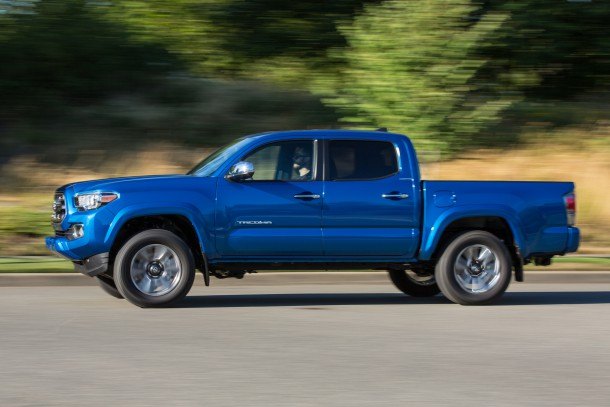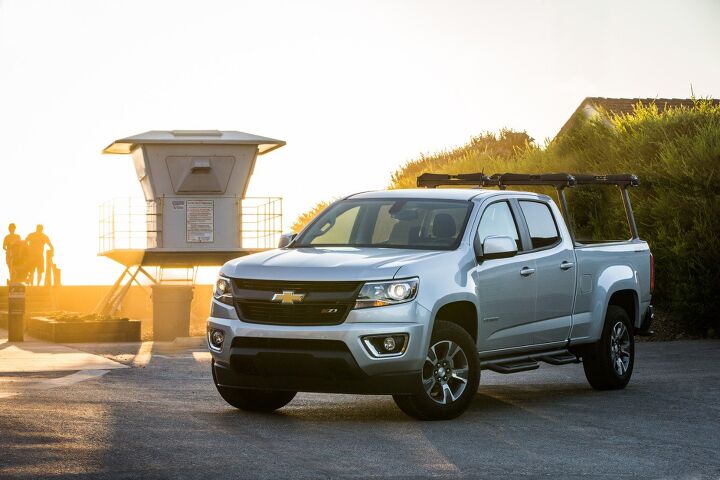Nearly Half of All Midsize Trucks Sold in America Are Toyota Tacomas
Competition improves the breed?
In order to tighten its grasp on the American midsize truck market, the Toyota Tacoma was thoroughly refreshed for model year 2016, a necessary development following the arrival – finally – of all-new competition at the end of 2014.
Evidently, Toyota did not need to debut an all-new pickup truck in order to fend off new General Motors challengers and keep its hold on a segment Toyota has led since 2005.
Want proof? Nearly half the non-full-size pickup trucks sold in the United States in the first two months of 2016 were Toyotas.
Up from 44.6 percent market share during the first two months of 2015, Toyota’s gain of two percentage points worth of market share one year later comes as GM’s sales growth in the category essentially stalls. The production limitations at the GM factory in Wentzville, Missouri, where the Chevrolet Colorado and GMC Canyon are built, is one major factor. In addition, however, GM has been unable to deliver in-demand diesel versions of its new trucks to an extent.
As a result, after selling 17,223 Colorados and Canyons in the first two months of 2015, GM’s midsize truck sales total increased by only 389 units in the same period one year later, an inconsequential increase given the 8-percent improvement recorded by the segment and the overall pickup truck sector’s 4-percent increase. As U.S. pickup truck sales climbed 7 percent in February, specifically, the GMC Canyon cancelled out a portion of the Chevrolet Colorado’s 13-percent improvement with its first year-over-year decline since the nameplate’s return in 2014.
The implication is not that GM’s midsize trucks are stumbling, not by any means. But a production increase is obviously vital. And based on the Tacoma’s response to greater availability of competitors in the past, that production increase won’t seriously alter the Toyota’s knack for selling half again as often as the GM twins.
Meanwhile, Toyota is turning up the wick on their own pickup truck production, as well.
Clearly U.S. sales of the Toyota Tacoma were unaffected by new competitors in 2015, but Nissan Frontier volume fell to a three-year U.S. low. The Frontier is rebounding in early 2016 with a 10-percent improvement to 13,197 sales in January and February, greater than the total of the GM duo’s better-selling Colorado. In fact, January and February represent a better start to 2016 than the Frontier managed in 2014, when sales of Nissan’s midsize truck shot up to an eight-year high.
For the most part, there are a great deal of similarities in the approaches taken by Toyota, General Motors, and Nissan: four and six-cylinder engines, extended and crew cab bodystyles, rear or four-wheel-drive. The arrival of the second-generation Honda Ridgeline later in the second-half of 2016, has the potential to shake up the category once again. The Ridgeline is an indirect truck rival for these true pickups: a six-cylinder, crew cab, front or all-wheel-drive crossover-based truck with ingenious bed solutions but questionable ruggedness.
Lest you think the Ridgeline has no capacity for insurgence, remember that the first-generation Ridgeline was initially common. Somewhat common. American Honda sold more than 50,000 Ridgelines in 2006, claiming 8 percent of the non-full-size truck market. The Ridgeline’s decline, persistent and severe, wasn’t just the result of consumer inattention. Honda seemingly forgot about the Ridgeline, too.
Between 2010 and 2015, Honda sold fewer than 15,000 Ridgelines per year, on average. The new Ridgeline is certainly expected to improve upon those totals. The Tacoma’s annual sales totals are unlikely to be hindered, but perhaps Honda will keep Toyota from claiming over half of all midsize truck sales in America.
On the whole, midsize trucks are producing a rising percentage of U.S. truck sales. 15.2 percent of the pickup trucks sold in 2015’s first two months were Tacomas, Colorados, Canyons, Frontiers, and Ridgelines. Even with the Ridgeline’s entrenched hiatus, that figure grew to 15.7 percent in 2016’s first two months.
Granted, on its own, the Ford F-Series produces more than three out of every ten trucks sold in America.
[Image: Toyota, General Motors, Honda]
Timothy Cain is the founder of GoodCarBadCar.net, which obsesses over the free and frequent publication of U.S. and Canadian auto sales figures. Follow on Twitter @goodcarbadcar and on Facebook.
More by Timothy Cain
Latest Car Reviews
Read moreLatest Product Reviews
Read moreRecent Comments
- Cprescott No big loss. It was always third rate when there was competition. At best its only good point was its price point.
- ToolGuy Journalists saving the world again. LOL.
- Stars9texashockey The Lyriq is selling better because it's discounted now. l think Lincoln does a much better job of styling their SUV's than Cadillac (except for Navigator vs. Escalade,) but they don't sell.However, Cadillac continues to offer sedans where Lincoln doesn't.
- SCE to AUX At this point, I don't know who the target customer is for Cadillac. I have zero interest.
- Cprescott Cadihack styling is stale - the interiors have not been luxurious, and the V-Series should be the base models in order to make waves. Until this company ditches the putrid and hideous pre-dented look of Arts and Scientology (!), the company is going nowhere.




































Comments
Join the conversation
Big Al--My wife's CRV does very well in the snow with AWD. Agree not everyone drives a pickup off road and much of the off road driving is more recreational and less necessity. My 4 x 4 Isuzu does fine in the snow.
Another student in my dojo bought a new Tacoma. Traded in a Fit, too. The truck looks less bloated than the previous generation and seems very nice overall. But the factory lift is a little insane. People do not mod Wranglers in such amounts often, and this is made right there in San Antonio like that, and is apparently how almost all of them come nowadays.